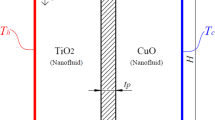Abstract
Phase change process of a melting pure metal in rectangular enclosures has been studied by finite difference-control volume method. The vertical walls are maintained at constant heat flux on the one side and constant temperature on the other while the horizontal ones are kept adiabatic. An enthalpy formulation with fixed grid has been developed to study phase change process where the solid–liquid phase change region is controlled by natural convection. This method is based on the description of the phenomenon by source terms defined by the evolution of latent heat. The flow of the solid– liquid interface zone is modeled by the Darcy porous medium, whose permeability is governed by the Carman–Kozeny relation. It is found that an important parameter controlling the heat transfer and fusion velocity is the applied heat flux. It is found also that the heat transfer goes through a maximum at an optimal value of the aspect ratio of about one.
Similar content being viewed by others
Author information
Authors and Affiliations
Additional information
Received on 13 September 1999
Rights and permissions
About this article
Cite this article
Mbaye, M., Bilgen, E. Phase change process by natural convection–diffusion in rectangular enclosures. Heat and Mass Transfer 37, 35–42 (2001). https://doi.org/10.1007/s002310000095
Issue Date:
DOI: https://doi.org/10.1007/s002310000095




